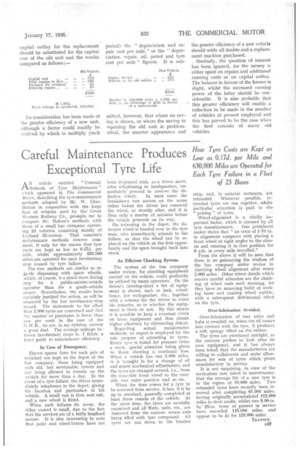Careful Maintenance Produces Exceptional Tyre Life
Page 51

If you've noticed an error in this article please click here to report it so we can fix it.
How Tyre Costs are Kept as Low as 0.17d. per Mile and 630,000 Miles arOperateA for Each Tyre Failure in a Fleet
of 23 Buses
AN article entitled "Unusual NIethods of Tyre Maintenance," which appeared in The Commercial Motor, describing the tyre-maintenance methods adopted by Mr. W. Chas: Bolton in connection with the large fleet of vehicles used by the' Great Western Railway Co., prompts me to compare Mr. Bolton's methods with those of a small has company operating 23 vehicle-s, consisting mainly of Leyland 32-seaters. That concern's maintenance methods deserve comment, if only for the reason that tyre costs are kept as low as 0.17d. per mile, whilst approximately 630,000 miles are operated for each involuntary stop caused, by tyre .failure.:
The two methods are similar as regards dispensing with' Spare Wheels, which, of course, is a much more daring step for a public-service-vehicle operator than for a goods-vehicle owner. Nevertheless, the results have certainly justified the action, as will he observed by the low involuntary-stop record. The statements to the effect that 3,000 tyres are concerned and that the number of punctures is fewer than one per week in the case of the G.W.R., do not, in my opinion, convey a great deal. The average mileage between involuntary stops is, I think, a truer guide to maintenance efficiency.
In Case of Emergency.
. Eleven spares (one for each pair of vehicles) are kept at the depot of the bus company, these being equipped with old, but serviceable, covers and not being allowed to remain on the vehicle for more than a day. In the event of a tyre failure, the driver immediately telephones to the depot, giving his location and particulars of his vehicle. A small van is then sent Out, and a new wheel IS fitted.'
When such failures do occur, the delay caused is email, due to the fact that the services are of a fairly localized maitre. It: is also interesting to note that jacks and wheel-braces have not been dispensed with, as a driver must, after telephoning to headquarters, immediately proceed to remove the de fective wheel. In most cases the breakdown van arrives on the scene either before the driver has removed the wheel, or shortly after, and it is then only a matter of minutes before the vehicle proceeds on its way.
On returning to the depot, the defective wheel is handed over to the tyre man, who immediately attends to the failure, so that the wheel can be replaced on the vehicle at the first opportunity and the spare brought back into stock.
An Efficient Checking System.
The system of the leis company under review, for checking equipment carried on the Vehicle, could profitably be utilized by many operators. On the driver's running-sheet' a list of equipment is shown, such as jack, wheelbrace, fire extinguisher, etc., together with a column for the driver to enter his remarks,. as to whether the equipment is there or not. By this means it is possible to keep a constant check on loose equipment and thus obtain higher efficiency by eliminating delays.
Regarding actual maintenance methods, an expert is employed for the sole purpose of Attending to tyres. Every tyre is tested for pressure twice a week, special attention being given to those showing a continual loss. When a vehicle has run 3,000 miles, it is brought in for a change of oil and minor mechanical adjustments, and the tyres are changed around, i.e., from the near-side front wheel to the nearside rear outer position and so on.
When the time comes for a tyre to he removed from service, it has, if it be up to standard, generally completed at least three rounds of the vehicle. At the same time, the tyres are carefully examined and all flints, nails, etc., are iemoved from the carcass, severe cuts being filled with tyre compound. All tyres are run down to the breaker strip, and, in suitable instances, are retreaded. Wherever possible, retreaded tyres are run together, whilst particular attention is paid to the pairing " of tyres.
Wheel-alignment is a vitally important factor, which is stressed by all
tyre manufacturers. One prominent maker states that "an error of 1-10 in.. in alignment compares with placing a front wheel at right angles to the chassis and running it in that position for 9 yds. in every mile travelled."
From the above it will be seen that there is no gainsaying the wisdom of the bus company under review, in checking' wheel alignment after every 3,000 miles. Other minor details which receive careful attention are the checking of wheel nuts each morning, for they have an annoying habit of working loose and causing wheel wobble, with a subsequent detrimental effect on the tyre.
Over-lubrication Avoided.
• Over-lubrication of rear axles , and hubs is avoided, as, when the oil come into contact with the tyre, it produces a soft, spongy effect on the rubber.
The tyres are purchased outright, as the concern prefers to look after its own equipment, and it has always been found that the manufacturers are willing to collaborate and make allowances for sets of tyres which'prove unsatisfactory in service.
It is not surprising, in view of the meticulous care taken in maintenance, that the average life of a new tyre is in the region of 70,000 miles. Two retreaded tyres have recently been removed after completing 01,000 miles. having originally accumulated 11200 miles to their credit, whilst two 9.00-in. by 20-in. tyres at present in service have exceeded 115,000 miles, andappear to be fit for 120,000 miles. .,. TRANSEN. e37




























































































